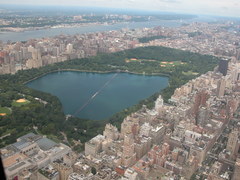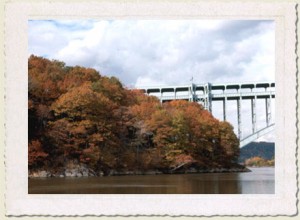Observations on society and civilization
Part 2 in a series.
John Muir once told Edward Harriman that he was “wealthier” because while he had much less money, he knew exactly how much he needed to live comfortably. Stepping back and looking at society and civilization from the perspective of a John Muir …

Aerial view of northern Manhattan, showing the Jackie Onasis Resevoir, Central Park, the Upper East Side, the Upper West Side, and southern Harlem.
I commute, on a daily basis, to a job in New York City, some 45 miles north of my home in New Jersey. This commute is accomplished via car and bus, at an average speed of 30 miles per hour. If I was to I leave my home at 6 AM, and travel as Thoreau might suggest, by walking, I could cover the distance in 15 hours, and arrive at 9 PM. This would not be practical, since the purpose is to arrive, work, and go home, not travel, enjoy the sights, and learn. I could make the trip on a bicycle in 3 to 4 hours. While bicycling 6 to 8 hours each day would be terrific cardiovascular exercise, this would not be practical in conjunction with the need to work 8 hours per day. The cars and buses are heated and air conditioned, so I and other commuters are comfortable year round, despite the air conditioning that is so cold that in the summer that we need sweaters, the heat that is so hot that in the winter we perspire, and the traffic that cuts our average speed from 50 or 60 mph to 30 on a good day.
During my commute I read, sleep, listen to music, write, or work. I can be productive with a laptop computer or hand-held cellphone, email device, or book. Sometimes I non-productively talk to strangers I encounter on the way. If I listen to music, it is on a hand held battery powered device with the capability of storing and playing back 10,000 songs, and a smaller but similarly astounding number of videos. The capacity is such that I could listen to the device 24 hours per day, non-stop, awake or asleep, for a month, without hearing the same song twice. Yet the device, including headphones and battery charger weighs a few grams. Similar devices make phone calls, take pictures, can browse the Internet and transmit and receive e-mail messages while playing music or video.
This essay was drafted on a small portable hand held computer while riding the bus. That device can also browse or “surf” the Internet, and send and retrieve e-mail, and make telephone calls. It can be used almost anywhere in the world. The bus drives past Newark Liberty International Airport, a way station used by 835 thousand people in 1949, its first full yearof operation, and 36 million people in 2006, the most recent year for which I have statistics,1 to travel to and from destinations all over the world.
If I walk home from the bus most of the lawns by which I walk are manicured, watered, fertilized, and sprayed with pesticides. They are a uniform deep green, but if you look beneath the surface, unhealthy and unnatural. You also don’t want to look too closely at the surface – there are pieces of litter – at least one piece every 5 or 10 square meters (approximately 50 or 100 square feet) on the major streets. These include cigarette boxes, plastic water bottle, metalized plastic ‘juice boxes’, foam, cardboard, and plastic single-use coffee cups, soda cans, beer cans, newspapers. There are also shredded strands of plastic, originally from shopping bags, dangling from trees. All of this stuff is considered “disposable.” Almost nothing is biodegradeable. Every day there is more.
Manhattan, where I am employed in this process called “work,” for which I am paid in stuff called “money” and “benefits” is terrific and fascinating. It is vibrant, hectic, and crowded. Except for 136 acres of forest and salt marshes of the Shorakapok Preserve, Manhattan is considered “completely developed,” which means paved and covered with buildings. There is no “undeveloped” land. The open space is either park, gardens, or the site of a building that no longer exists and will be redeveloped as soon as the plans can be finalized and resources mobilized These structures range from small one-story structures to skyscrapers that are 30 or 50 stories tall, or in the case of the Empire State Building, reach 86 stories and 1250 feet into the sky. The “Freedom Tower,” which will be built on the site of the World Trade Center, will be taller.
An island, Manhattan is bounded by water; the Harlem, Hudson, and East Rivers to the north, west and east, and New York Harbor to the south. While there is ample rainfall, there are no natural streams outside of the Shorakapok. Even the Jackie Onasis Resevoir, Turtle Pond, Conservatory Pond, The Pond, The Lake in Central Park are fed and drained by pipes. Rain water that doesn’t soak into what little soil remains unpaved and exposed flows along the streets into storm sewers, and then flows out to sea in underground pipes. Clean water for drinking, cooking, bathing, etc, flows into the city and each home, office, and store via underground pipes. Dirty water flows out via the sanitary sewers.
Like water, sewage, and electricity, people travel underground. We use a complex system of tunnels wide enough for four railroad trains to run past each other, each with 8 to 11 cars that can each carry 240 people. This system is cut through the bedrock of Manhattan and interconnects Manhattan, Brooklyn, Queens, and the Bronx.
I work on the 28th floor of a 35 story building. To get to my desk I walk into an elevator, push a button, wait, and about 32 seconds later emerge approximately 400 feet above the point at which I started. Taking the steps upstairs would take a whole lot longer than 32 seconds.
My job is to manage and maintain a set of computers so the other people in the firm can respond to matters of law and questions of liability. Some of us effectively write by speaking into a microphone which is attached to a personal computer. Software on the computer translates the sounds into words.
Impressive, yes. Natural, not really.
